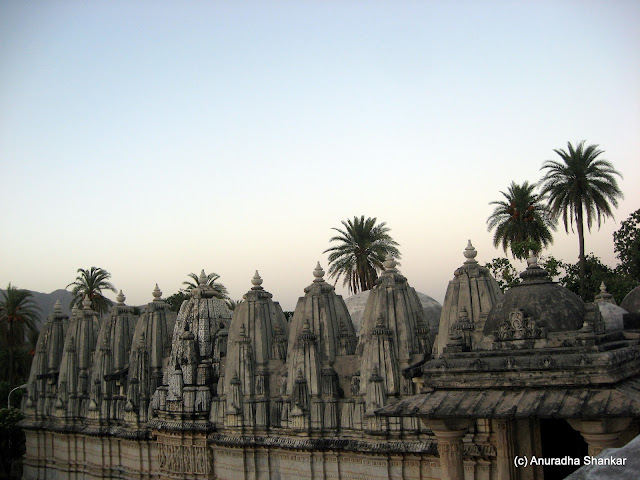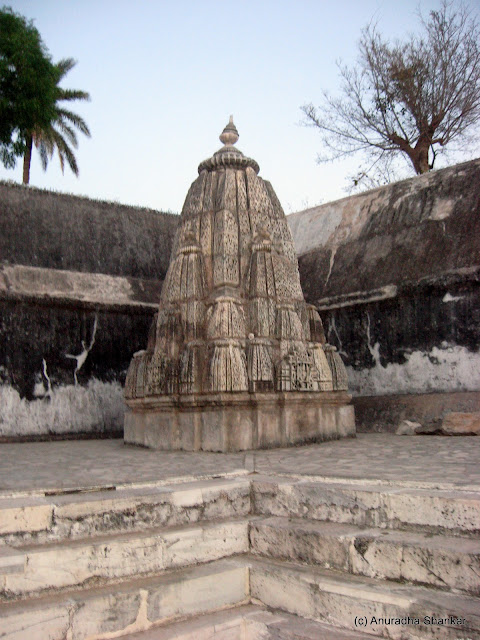The year was 1290 . A crowd had gathered around a clearing, where broken down pillars marked the presence of an ancient temple, now long gone. A young boy, just 14 years old, leaned against one of those pillars, deep in thought. Then, he began speaking, and the crowd fell silent, listening to his every word. He spoke without any notes, translating the Bhagavat Gita, from Sanskrit, which only the pundits knew, to the language everyone in the village knew and spoke – a variety of Prakrit which developed into the Marathi language. Even as he spoke, one of the men in the audience realized how momentous this event was, and how important this composition would be. He began writing down the words the young boy spoke, and this composition was named by its author and composer, the Bhavartha Deepika – the enlightening meaning (of the Bhagavat Gita). Now, the ancient, holy text, was no longer restricted to the pundits, but accessible to all, understood easily by them, composed as it was, in their...
Our trip to Ambaji was combined with a visit to Mount Abu
and Udaipur. We travelled mostly by local buses, and thanks to the timing of
our bus to Udaipur, we had a few extra hours at Ambaji, which we used to visit
a few more temples located in the area. We hired an auto for the purpose, and
left the temples to his discretion. Here is where he took us to.......
Chamunda Math
There seemed to be just one road leading from Ambaji – the highway,
and we turned off suddenly into a side road, which we hadn’t even noticed. The path
(I can’t even call it a road) weaved in and out of fields, and our noisy auto
scared away birds, as we made our way towards a temple spire we could see in
the distance.
What we took to be a temple turned out to be a math, an
ashram, and we were the only visitors on that day. The glass inlay work at the
entrance caught our eye at once.
The temple was empty; except for a couple of people busy
cleaning it. We approached the sanctum and prayed, and as we came down, we were
approached by a man who asked us where we were from. Hearing that we were from
Mumbai, he started reminiscing about the days he lived in the city. It seemed
he was a student there, who had given up the busy life of the city to live in
the peace of the ashram. He showed us around, taking us to the Samadhis (resting places) of his guru as
well as the previous heads of the math. Meanwhile, a couple of dogs had
succeeded in scaring Samhith, so we decided to move on to the next temple on
our agenda.
Kamakshi Temple
The second temple turned out to be a south Indian temple,
dedicated to the goddess Kamakshi. The temple is maintained by the Kanchi Math
(of Kancheepuram in Tamil Nadu) and houses images of the goddess in the 51 Shakti
Peethas.
Koteshwar Mahadev
The next temple was dedicated to Lord Shiva. This is
believed to be an ancient temple, built over the place where the sage Valmiki
had his ashram.
However, the place draws pilgrims, not for the temple, but
for a small pond, into which water flows perennially from a small opening in
the mountain, which is decorated with a cow’s head made of marble. It appears
as if the water flows out of the cow’s mouth. This is said to be the river Saraswati,
which is believed to originate in these hills. There is also a small cave
located below ground level, with a small idol of the goddess Saraswati.
Kumbhariya Jain Temples
We had seen enough Jain temples at Dilwara, so we had kept
the Kumbhariya Jain temples to the last, so that we could skip them if we didn’t
have time. We walked into the complex, all set to make a cursory round before
turning back. As it turned out, we spent more time here than we had anywhere
during the entire trip!!
As with all the other temples, this one was empty too. Surprising,
considering that it was the vacation, and that the Ambaji temple was packed! Guess
most visitors are ardent devotees who don’t go sightseeing!
The temple complex is comprised of five ancient temples dedicated
to the Jain Teerthankars – Neminath, Mahavir, Parshvanath, Shantinath and
Sambhavnath. These are believed to be older than the temples at Dilwara. The temple
to Neminath is believed to have been built by Vimal Shah, minister to the
Solanki ruler in Gujarat, in the 11th century, before he built the more
acclaimed Adinath temple at Dilwara. The other temples were built in the 12th
century by the brothers Vastupal and Tejpal, who also later built more temples
at Dilwara!
While some of this information was posted on a board right
at the entrance, I heard some more interesting things about the temple when I went
into the office to ask permission to take photographs. To begin with, the
official there, a representative of the trust, which maintains the temple, was
thrilled to have someone come and ask permission to take photographs. He informed
me that a small charge was levied, but once I had paid, I could take all the
photos I wanted. He further took on the role of unofficial guide and came
along, pointing out the more interesting sculptures and carvings. It was he who
told us of one of the legends surrounding the temple. It is believed that the
goddess Ambaji appeared to Vimal Shah in his dreams and instructed him to build
360 temples dedicated to the Jain Teerthankars. He did so, and when people
appreciated the temples, and asked who built them, he proudly replied that he
had built them himself, disregarding the role of the goddess. The goddess was,
of course, enraged, and one night, she destroyed 355 of the temples, leaving
just five as a reminder of his pride. Vimal Shah, of course, realised the error
of his ways, and, in the temples he later built at Dilwara, placed an image of
the goddess as atonement. Much as the story was interesting, it obviously did
not agree with the historical facts. However, it does make things more
interesting. Also, according to the board at the entrance, there were indeed
more temples in the complex, but they were destroyed by the Mughals.
We were the only visitors that day, and had all the time to
look around and enjoy the beautiful work. Besides, after Dilwara, where I had
to leave my camera in the car, I was thrilled to have a free run with my
camera! I wandered around, clicking so many photos that I cant possibly post
all of them! Besides, I cant possibly give details of all the sculptures and
temples I have taken photos of, so I can only post as many photos as I can and
show you the place through my eyes... or rather, my lens!
 |
| on the ceiling.. |
 |
| ceiling again! |
 |
| this is also the ceiling |

these are remnants of broken arches... we were told that these were found on the site... remnants of the other temples?
By the time we were through, it was time to bid goodbye to
Ambaji and proceed to Udaipur, where more exciting places awaited us!


















































Wow !! Such amazing places to visit in India. The craftsmanship was just so amazing back then. Even now some of it lives on . thanks for sharing.
ReplyDeleteThanks, Yasmin! Thats the beauty of these... those who make them pass on, but their creations live on!
DeleteWow , wonderful carvings .
ReplyDeleteAbsolutely!! this place is right up your street! u should go there sometime!
DeleteVery beautiful temples and great details.
ReplyDeleteThanks Mridula!
DeleteThat is a wonderful collection of temples. Nice photos.
ReplyDeletewww.rajniranjandas.blogspot.com
Thanks Raj!
DeleteBeautiful captures of the temples. You had a wonderful visit for sure.
ReplyDeleteThanks Indrani!
ReplyDeleteLoved the pictures and the post. You were lucky to find an auto that took you to such beautiful temples!
ReplyDeleteThanks, Archana! We were lucky indeed.. else we would have missed such a beautiful place! never imagined they would be as beautiful!
DeleteI like your blog it’s look nice and attractive. I visited many places in India and always remember that trips which i had traveled and photos are memories of it in my album and heart touching photos are always with me. Nice and awesome information with good looking photos. I always keep in touch with your blog and going to bookmark also.
ReplyDeleteThanks
Thanks India Tours!
DeleteA beautiful post with amazing pictures. Thanks for sharing, Anuradha:)
ReplyDeleteThanks Rahul!
DeleteIt was a real feast. Thanks.
ReplyDeleteThanks so much, PNS!
DeleteBeautiful goegeous captures and such wonderful temples. Would love to visit them in person sometime for sure!
ReplyDeleteIts a place u and your family will surely love!!
Deletesuperb…
ReplyDeletebangalorewithlove.com
thank you!
DeleteIts a marvel that they could build these temples with such precision in those days.
ReplyDeleteabsolutley, Haddock!!! building such amazing structures with just their hands is something that awes me as well!
DeleteThanks a lot!
ReplyDeleteWOW! beautiful collection of pictures of Temples around Ambaji. i saw each and every temple from very near and now i am planning to have a visit to the place. your article is so clear and very interesting as well. http://www.couponcodesindia.com/Airbnb.com/
ReplyDeletethanks a lot. Glad to have been of help
DeleteI liked the font u r using Anuradha...
ReplyDeletehyderabadonnet.com
classic…
ReplyDeletehyderabadonnet.com
Anuradha, do you know why Hindu temples have its shrine at the west end facing eastward and the temple having its entrance at the east?
ReplyDeleteit is believed that the east is the most auspicious direction, but practically, facing the sun as it rises makes sense, since the first light of the sun enters the house and lights up the house or temple, which is why the entrance is usually at the east...
DeleteI have a weakness for temples, and your collection of photos has just drilled the point. Beautiful! Thanks for sharing!
ReplyDeleteTHanks AR!!!
DeleteThis is so beautiful, and your photographs are in detail. It is like visiting the temple and watching those intricate designs. Fascinating architecture.
ReplyDeleteThanks for sharing them.
In both business and personal life, I’ve always found that travel inspires me more than anything else I do. Evidence of the languages, cultures, scenery, food, and design sensibilities that I discover all over the world can be found in every piece of my jewelry.
ReplyDeleteNice picture.This is great blog.
ReplyDeleteflowersbangalore.com